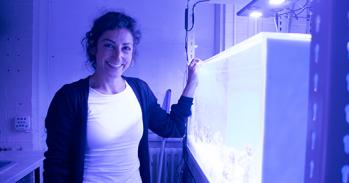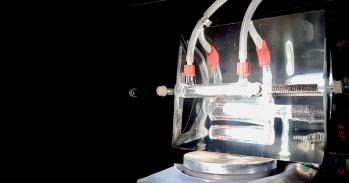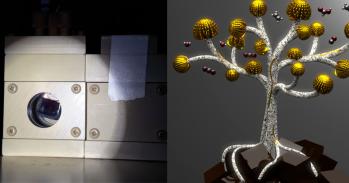
Dr Jenny Zhang is a group leader and BBSRC David Phillips Fellow in the Department of Chemistry, where she is re-wiring photosynthesis to generate renewable fuels. Here, she tells us about why she switched from cancer research to sustainability, how her Fellowship programme is helping her develop leadership skills, and why eggs in her childhood home would regularly go missing.
Dr Jenny Zhang is a group leader and BBSRC David Phillips Fellow in the Department of Chemistry, where she is re-wiring photosynthesis to generate renewable fuels. Here, she tells us about why she switched from cancer research to sustainability, how her Fellowship programme is helping her develop leadership skills, and why eggs in her childhood home would regularly go missing.
It was my mother who first got me interested in science. When I was very young, back when I was growing up China, she used to tell me bedtime stories about the origins of thunder and lightning, how radios work, or how eggs became chickens. This apparently had a profound effect on me. Eggs would regularly go missing from the kitchen and turn up buried snugly under some blankets in bed. Or the new radio would be found dismantled, presumably taken apart by someone who wanted a better look inside...
My PhD research was in medicinal chemistry. My aim was to design anti-cancer drugs that could penetrate deep into solid tumours. To achieve this, I synthesised a library of novel DNA intercalators and anti-cancer platinum complexes and studied their bio-distribution and metabolism within 3D-tumour models using a variety of chemical imaging techniques. My research was very much directed by the problem, which gave me opportunities to travel around the world to work in different labs and disciplines. I was able to arrive at new drug design strategies using this approach.
Environmental sustainability is important to me, so that’s why I moved into artificial photosynthesis. My PhD research was highly interdisciplinary and I developed a deep appreciation of how different approaches can breathe fresh ideas into old problems and can often catalyse breakthroughs. Artificial photosynthesis for sustainable fuel development is also a highly interdisciplinary field, and as a research area, it aligns with my personal values about the importance of environmental sustainability.
I came to the Department of Chemistry more than five years ago as a Marie Curie Incoming International Fellow to work on artificial photosynthesis in Professor Erwin Reisner’s group. I was excited by the notion that, coming from quite a different background, I would be able to bring unique perspectives into the field. I also liked the idea of being immersed in a new learning experience. It turned out to be more challenging – and at the same time more fulfilling – than I expected.
We’ve designed new catalytic systems to turn sunlight into 'solar fuels'. In my postdoctoral research, I was interested in turning sunlight into chemical fuels we call 'solar fuels' – sustainable and green alternatives to our current unsustainable and polluting carbon-based fuels. Plants have been carrying out this for millions of years through the process of photosynthesis, enabled by a set of special proteins that make up the photosynthetic electron transport chain. I coordinated a team that studied these enzymes and the reactions that they carry out. We incorporated them into several prototype systems that can use sunlight to turn water into hydrogen. We hope this work will help make such fuels available to everyone in future.
We still need to understand the basic chemistry and physics behind many components of photosynthesis. There are many fundamental questions that remain to be answered both within biological and artificial photosynthetic systems. Mainly, these relate to the flow of electrons and how they can be more efficiently generated and used in catalysis. During my postdoctoral research, I wired photosystem II, nature’s water oxidation enzyme that kick-starts photosynthesis, to custom-made electrodes to study enzyme functionality and to perform light-driven fuel forming reactions. This allowed me to understand the ‘bottlenecks’ of different types of photosynthetic systems, and where improvements need to be made.
My BBSRC Fellowship allows me to drive my own research vision with my own research group. I started my own research group in 2018, and my focus is to develop new tools and approaches for studying photosynthesis (both biological and artificial) and utilising it in renewable energy generation and agricultural/sensor technologies. I’m supported by a generous grant that enables me to have postdocs and the necessary equipment – in particular, a sophisticated 3D printer that can print a large variety of materials, from living cells to metals.
The Fellowship will also help me build my leadership skills. It aims to get Fellows on the trajectory to leading our own research groups confidently and successfully. We have a BBSRC mentor that comes to visit our lab once a year. I’ve also attended workshops where I learned about the economy of science and leadership. I really like that this scheme offers not just money but the necessary support to help me become a well-rounded leader in science. I feel incredibly lucky to have this opportunity.
I hope my career will lead to the uncovering of many ‘unknown unknowns’. I want to drive innovative and high-value research that addresses important problems in our world today, and I want to achieve this while fostering a healthy and positive lab culture. Like any scientist, I hope my career will lead to the uncovering of many ‘unknown unknowns’ that will leave a positive impact on the world.
It’s important to me that we inspire more students – both girls and boys – to choose science. I still turn up to meetings and workshops where I am either the only woman or one of the few women present. However, this is happening less and less, and I feel that there is a real effort being made by our institutions to be inclusive and to lower barriers. The old barriers still exist, but I’m optimistic since I know how determined women can be.
In the meantime, I think we shouldn’t forget about positive action being needed to foster men to challenge their own status quo to become strong counterparts of the future.

The text in this work is licensed under a Creative Commons Attribution 4.0 International License. Images, including our videos, are Copyright ©University of Cambridge and licensors/contributors as identified. All rights reserved. We make our image and video content available in a number of ways – as here, on our main website under its Terms and conditions, and on a range of channels including social media that permit your use and sharing of our content under their respective Terms.




